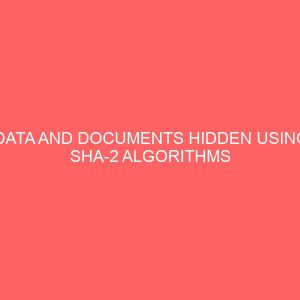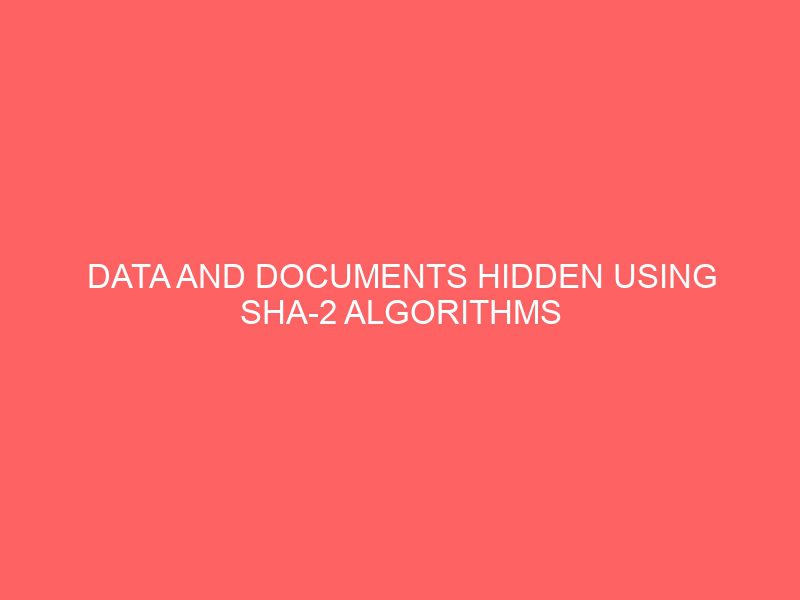Description
CHAPTER ONE
INTRODUCTION
- Background of study
This project is on Data and documents hidden using sha-2 algorithms and steganography. In the field of Data Communication, security-issues have got the top priority. Internet users frequently need to store, send, or receive private information. The most common way to do this is to transform the data into a different form. The resulting data can be understood only by those who know how to return it to its original form. This can be done using 2 forms of Cryptography namely SHA-2 and Steganography. In 1993 the Secure Hash Standard (SHA) was first published by the NIST and in 1995 this algorithm was reviewed in order to eliminate some of the initial weakness, in 2001 new Hashing algorithms were proposed. This new family of hashing algorithms known as SHA-2, use larger digest messages, making them more resistant to possible attacks and allowing them to be used with larger blocks of data, up to 2128 bits, e.g. in the case of SHA512. The SHA-2 hashing algorithm is the same for the SHA256, SHA224, SHA384, and SHA512 hashing functions, differing only in the size of the operands, the initialization vectors, and the size of the final digest message.While for Steganography its said to be of Greek origin and it means “concealed writing” from the Greek words steganos (στεγανός) meaning “covered or protected”, and graphia (γραυή) meaning “writing”. The first recorded use of the term was in 1499 by Johannes Trithemius in his Steganographia, a treatise on cryptography and steganography disguised as a book on magic (Choon, 2012; 2013).
The 2 forms of securing our files are basically used to ensure we have confidential data like image, text, video, and audio, in such a way that unauthorized access is limited. Authors prefer a multilayer security by using the benefits of sha-2 and steganography. This 2 implementations can be done through various formats available worldwide. Various formats preferred are .jpeg, .gif, .png, .mp3, .mp4, .doc, .docx .bmp. Due to ease of availability of these formats on the internet, they are preferred to hide the secret message. Hashing systems such as the use of hash-2 and Steganography have advanced over the years due to constant security breach experienced by their users. Many tools and technologies created takes advantage of steganography techniques like coding in image, null ciphers, videos, audio, etc. (Cachin, 1998).
The goal of cryptography is to avoid drawing suspicion to the existence of a hidden message. This approach of information hiding technique has recently become important in a number of application areas. Digital audio, video, and pictures are increasingly furnished with distinguishing but imperceptible marks, which may contain a hidden copyright notice or serial number or even help to prevent unauthorized copying directly (Chen and Wu, 2009).
Military communications system makes increasing use of traffic security technique which, rather than merely concealing the content of a message using encryption, seek to conceal its sender, its receiver or its very existence. Similar techniques are used in some mobile phone systems and schemes proposed for digital elections.
Some of the techniques used in steganography are domain tools or simple system such as least significant bit (LSB) insertion and noise manipulation and transform domain that involve manipulation algorithms and image transformation such as discrete cosine transformation and wavelet transformation. However, there are techniques that share the characteristic of both of the image and domain tools such as patchwork, pattern block encoding, spread spectrum methods and masking.
In contrast, steganography does not alter the structure of the secret message but hides it inside a cover-image so it cannot be seen. A message in cipher-text, for instance, might arouse suspicion on the part of the recipient while an “invisible” message created with steganographic methods will not. In other word, steganography prevents an unintended recipient from suspecting that the data exists. In addition, the security of classical steganography system relies on secrecy of the data encoding system. Once the encoding system is known, the steganography system is defeated. It is possible to combine the techniques by encrypting message using cryptography and then hiding the encrypted message using steganography. The resulting stego-image can be transmitted without revealing that secret information is being exchanged. Furthermore, even if an attacker were to defeat the steganographic technique and detect the message from the stego-object, he would still require the cryptographic decoding key to decipher the encrypted message.
1.2 Problem of Statement
In today’s society the most practical implementation of steganography is used in the world of computers. Data is the heart of computer communication and over the years a lot of methods have been created to accomplish the goal of using steganography to hide data. The trick is to embed the hidden object into a significantly larger object so the change is undetectable by the human ear.
As stated earlier, visible encrypted messages will draw suspicion from others. This will make them attempt to decrypt the cipher text. Indirectly it raises the chance of message being viewed by third party in the exception of sender and viewer. However, by hiding or embedding the text file into image, it is hard to raise the suspicion of others whether it contains any secret message or not as the processed image had not look different from the original image in naked eyes. This will make the message more secure. Indirectly, only the sender and receiver know the treat behind the image and hence ensure that the message can only be viewed by the sender and receiver.
1.3 Aim and Objectives
The primary aim of this project is to encode a message in an image in a way that avoids drawing suspicion to the transmission of the hidden message.
This project also comprehends the following objectives:
- To store a text file (.txt) in image.
- To protect the text file (.txt) from being viewed by third party using encryption.
- To restore the stored text file in image.
1.4 Definition of Terms
Steganography: Steganography is defined as the system of hiding secret or a confidential data in a cover media like image, text, video, audio, in such a way that none other than the intended recipient knows the presence of data. “Steganography” is the art and science of communicating in a way which hides the existence of the communication.
Cryptography: Cryptography is used to provide security to the plain text. It is used to encrypt the message with key so that no intruder can read the message and decrypt to get the message back.
Stego-object: Refers to the object which is carrying a hidden message. So, given a cover object, and a message the goal of the steganographer is to produce a stego object which would carry the message.
Stego-image: Refers to the object used as the carrier to embed messages into. Many different objects have been employed to embed messages into for example images, audio, and video as well as file structures, and html pages to name a few.
LSB: Least Significant Bit.
Cipher-text: The text representing the original text on encryption.
Cryptosystem: This is a system for encryption and decryption of information.
RGB: It is an acronym for colour images which means Red, Green and Blue.








Reviews
There are no reviews yet.